Newspapers and Clippings
Chamber Concert Review Clipping (1929)
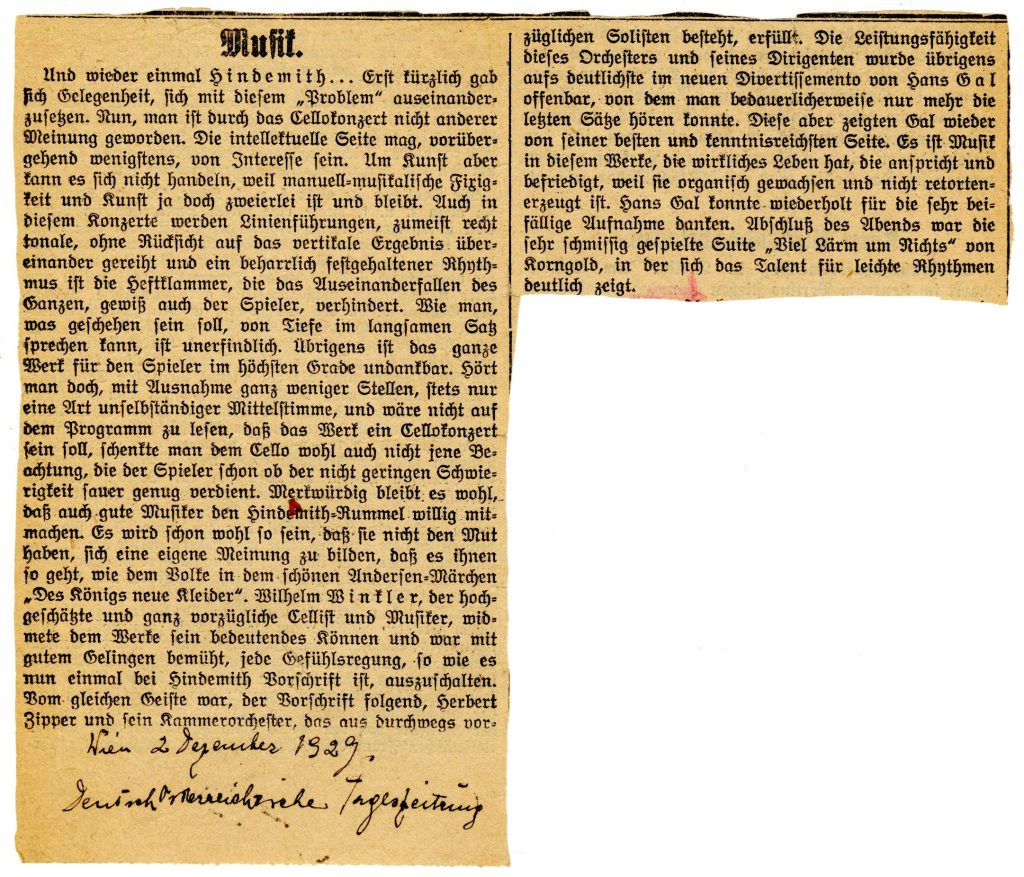
Music.
And it’s Hindemith, yet again. . . We had occasion to deal with this “problem” rather recently. Well, nothing has changed after the present cello concerto. The intellectual side may, at least temporarily, be of interest. Art, however, is not the question here, because manual-musical speed and art remain two separate matters indeed. Again in this concerto, melody lines, mostly entirely tonal ones, are placed on top of one another without regard for the vertical[1] result and a tenaciously preserved rhythm is the binding that prevents the whole, including the performer, from falling apart. It is unfathomable how one might speak in depth about what is supposed to be happening in the slow movement. Furthermore, the whole work is thankless to the performer in the highest degree. One hears, with the exception of very few moments, a sort of insufficient middle voice throughout, and if one were not able to read in the program that this work is supposedly a cello concerto, one would hardly be cognizant that the performer deserves recognition, earned bitterly enough on account of the performer’s great effort. It is odd that even good musicians voluntarily take part in this Hindemith fuss. It must be that they do not have the courage to construct an independent opinion and that they thus find themselves in the same lot as the people in the lovely Andersen fairy tale “The King’s New Clothes.” Wilhelm Winkler, the highly lauded and most exquisite cellist and musician, dedicated his formidable skill to this work and labored, with great success, to switch off every stirring of emotion, as is customarily the rule with Hindemith. Observing this rule, Herbert Zipper and his chamber orchestra, which consists entirely of exquisite soloists, was filled with the same spirit. The capability of this orchestra and its director was, incidentally, most readily apparent in Hans Gal’s new Divertissemento, of which one could, regrettably, only hear the last movements. These movements however once again showcased Gal’s best and most erudite side. In this work there is music that has real life, music that demands and satisfies because it has grown organically and is not generated chemically. Hans Gal was able to repeatedly express his gratitude for the very favorable reception. The evening’s conclusion was the very dashingly played suite “Much Ado about Nothing” by Korngold, in which his talent for simple rhythms is well on display.
Handwriting: Vienna, 2 December 1929, German-Austrian Daily Newspaper
[1] That is, harmonic.
Brooklyn Symphony Orchestra New York Herald Tribune Clipping (March 9, 1949)
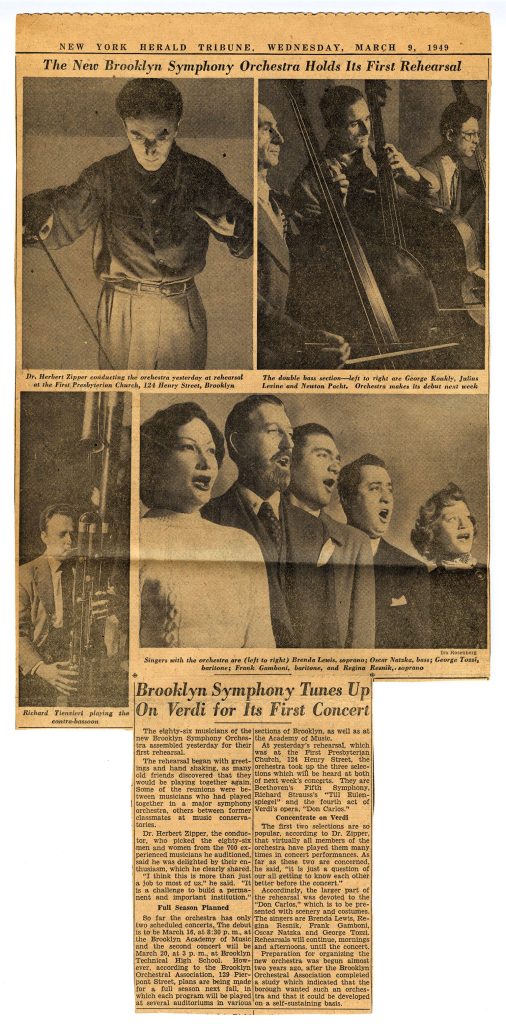
New York Herald Tribune, Wednesday, March 9, 1949
The New Brooklyn Symphony Orchestra Holds Its First Rehearsal
Brooklyn Symphony Tunes up on Verdi for its First Concert
The eighty-six musicians of the new Brooklyn Symphony Orchestra assembled yesterday for their first rehearsal. The rehearsal began with greeting and hand shaking as many old friends discovered that they would be playing together again. Some of the reunions were between former classmates at music conservatories. Dr. Herbert Zipper, the conductor, who pocked the eighty six men and women from the 700 experienced musicians he auditioned said he was delighted by their enthusiasm, which he clearly shared. “I think this is more than just a job to most of us,” he said. “It is a challenge to build a permanent and important institution.
Full Season Planned
So far the orchestra has only two scheduled concerts. The debut is to be March 16, at 3:30 p.m. at the Brooklyn Academy of Music and the second concert will be March 20, at 3 p.m. at Brooklyn Technical High School. However, according to the Brooklyn Orchestral Association, 129 Pierpont Street, plans are being made for a full season next fall in which each program will be played at several auditoriums in various sections of Brooklyn, as well as at the Academy of Music. At yesterday’s rehearsal, which was at the First Presbyterian Church, 124 Henry Street, the orchestra took up the three selections which will be heard at both of next week’s concerts. They are Beethoven’s Fifth Symphony, Richard Strauss’s “Till Eulenspiegel” and the fourth act of Verdi’s opera, “Don Carlos.”
Concentrate on Verdi
The first two selections are so popular, according to Dr. Zipper, that virtuaraly all members of the orchestra have played them many times in concert performances. As far as these two are concerned, he said, “it is just a question of our all getting to know each other better before the concert.” Accordingly, the larger part of the rehearsal was devoted to the “Don Carlos,” which is to be presented with scenery and costumes. The singers are Brenda Lewis, Reginn Resnike, Frank Gamboni, Oscar Nataka, and George Tozzi. Rehearsals will continue, mornings and afternoons, until the concert. Preparation for organizing the new orchestra was begun almost two years ago, after the Brooklyn Orchestral Association completed a study which indicated that the borough wanted such an orchestra and that it could be developed on a self-sustaining basis.
Manila Symphony Society “Carmen” Manila Times Clipping (August 30, 1956)
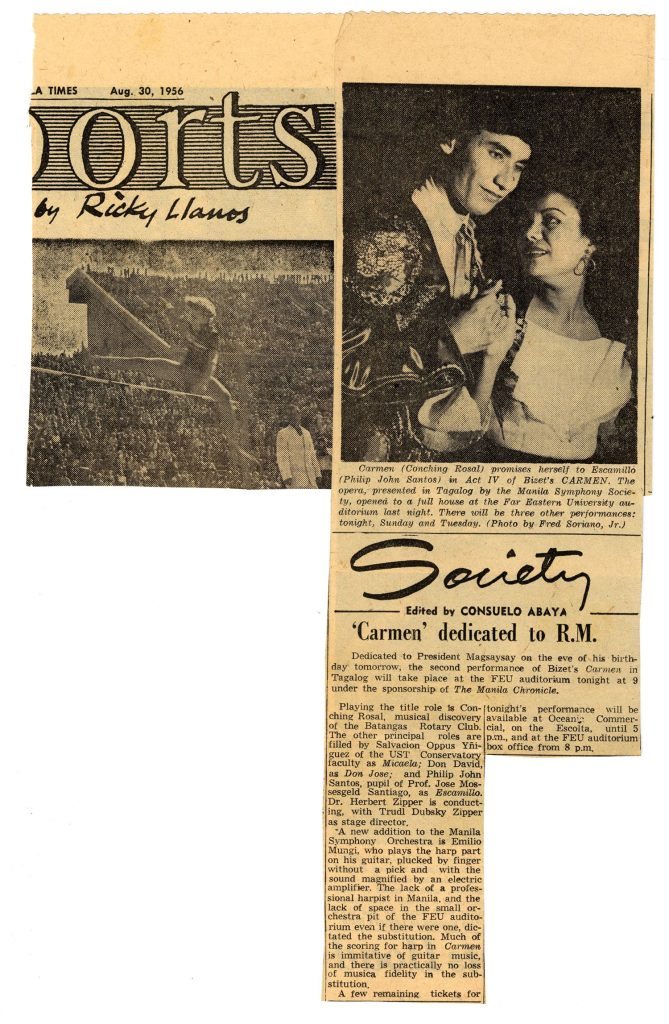
Society
Edited by Consuelo Abaya
‘Carmen’ dedicated to R.M.
Dedicated to President Magasaysay on the eve of his birthday tomorrow, the second performance of Bizet’s Carmen in Tagalog will take place at the FEU auditorium tonight at 9 under the sponsorship of The Manila Chronicle.
Playing the title role is Conching Rosal, musical discovery of the Batangas Rotary Club. The other principal roles are filled by Salvacion Oppus Yniguez of the UST Conservatory faculty as Micaela; Don David, as Don Jose; and Philip John Santos, pupil of Prof. Jose Mossesgeld Santiago as Escamillo. Dr. Herbert Zipper is conducting, with Trudl Dubsky Zipper as stage director.
A new addition to the Manila Symphony Orchestra is Emilio Mungi, who plays the harp part on his guitar, plucked by finger without a pick and with the sound magnified by an electric amplifier. The lack of a professional harpist in Manila, and the lack of space in the small orchestra pit, of the FEU auditorium even if there were one, dictated the substitution. Much of the scoring for harp in Carmen is imitative of guitar music, and there is practically no loss of musica fidelity in the substitution.
A few remaining tickets for tonight’s performance will be available at Oceanic Commercial, on the Escolta, until 5 p.m., and at the FEU auditorium box office from 8 p.m.
Music Center of the North Shore 10th Anniversary Article (April 16, 1964)
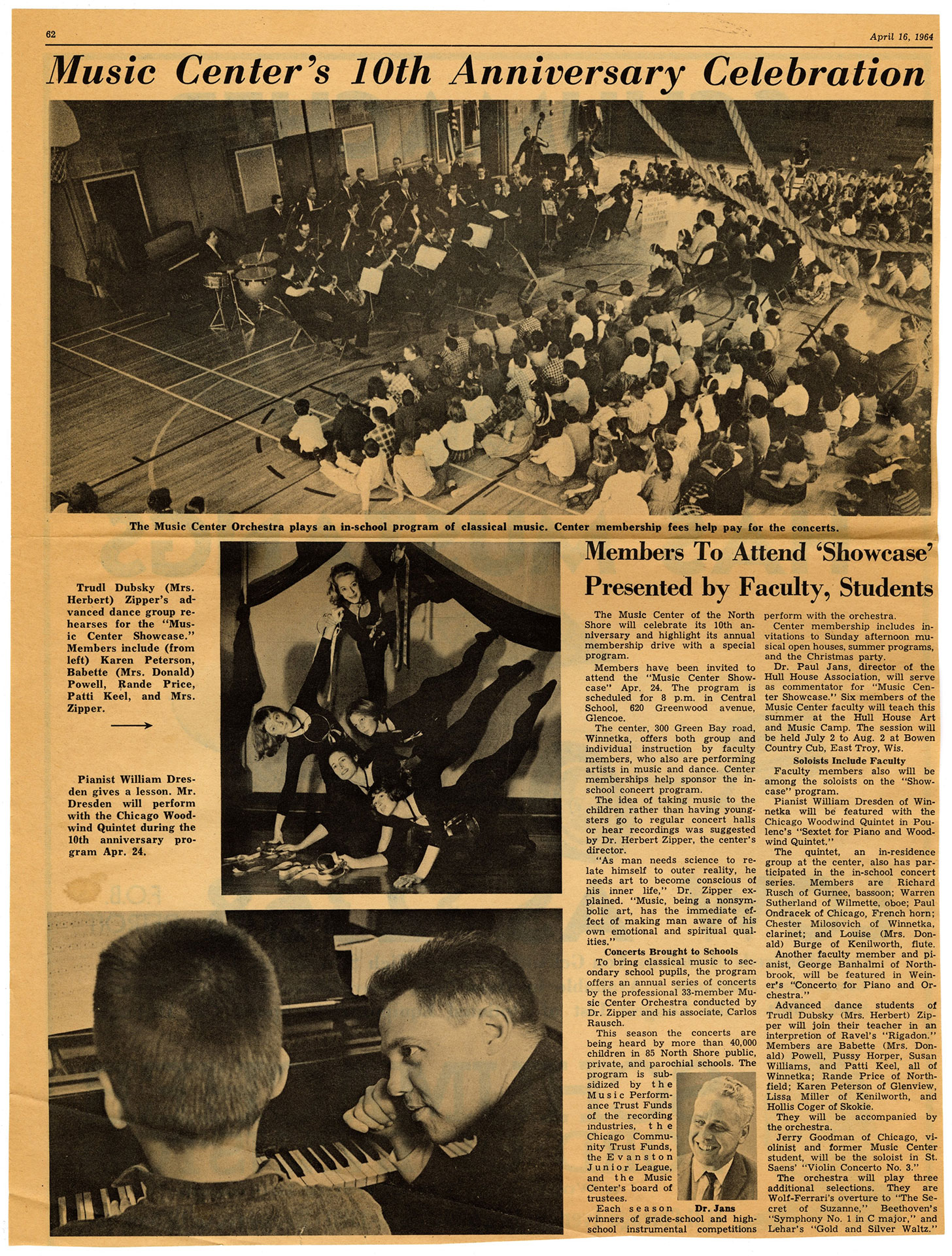
Music Center’s 10th Anniversary Celebration
Members to Attend ‘Showcase’
Presented by Faculty, Students
The Music Center of the North Shore will celebrate its 10th anniversary and highlight its annual membership drive with a special program. Members have been invited to attend the “Music Center Showcase” Apr. 24. The program is scheduled for 8 p.m. in Central School, 620 Greenwood avenue, Glencoe. The center, 300 Green Bay road, Winnetka, offers both group and individual instruction by faculty members, who also are performing artists in music and dance. Center memberships help sponsor the in-school concert program. The idea of taking music to the children rather than having youngsters go to regular concert halls or hear recordings was suggested by Dr. Herbert Zipper, the center’s director. “As man needs science to relate himself to outer reality, he needs art to become conscious of his inner life,” Dr. Zipper explained. “Music, being a nonsymbolic art, has the immediate effect of making man aware of his own emotional and spiritual qualities.”
Los Angeles Times article featuring Herbert Zipper and his biographer Paul Cummins (January 27, 1991)
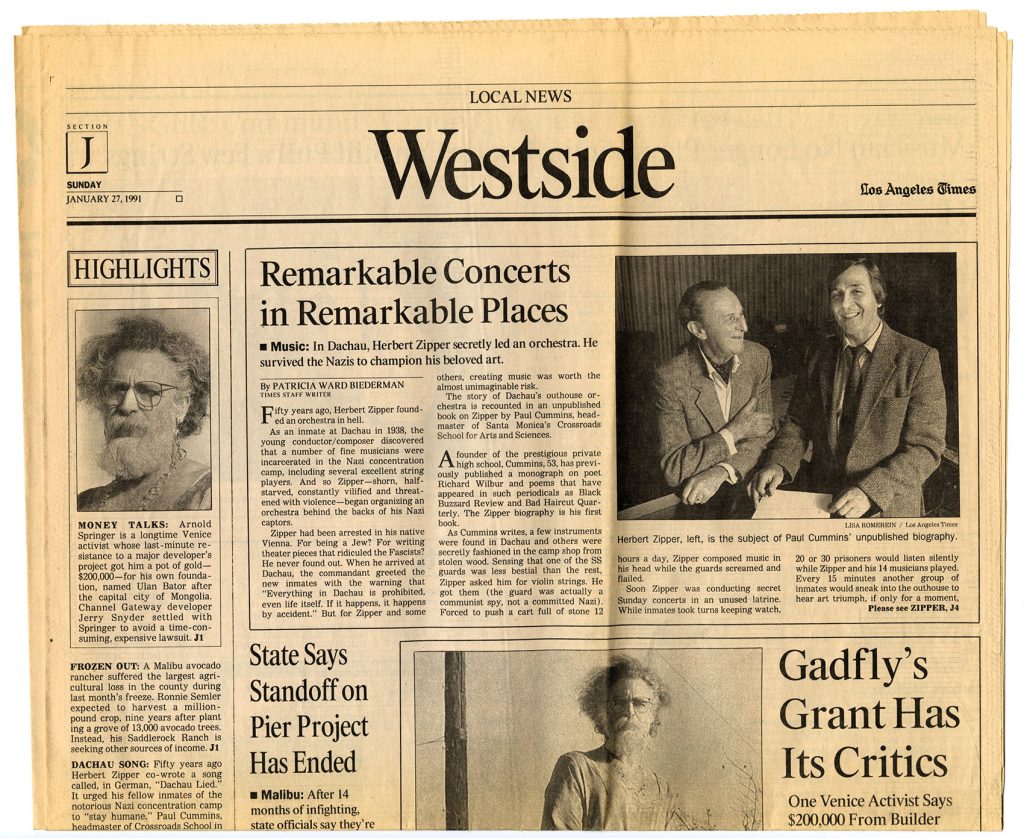
Remarkable Concerts in Remarkable Places
Fifty years ago, Herbert Zipper founded an orchestra in hell. As an inmate at Dachau in 1938, the young conductor/composer discovered that a number if the fine musicians were incarcerated in the Nazi concentration camp, including several excellent string players. And so Zipper — shorn, half-starved, constantly vilified and threatened with violence — began organizing an orchestra behind the backs of his Nazi captors.
Zipper had been arrested in his native Vienna. for being a Jew? For writing theatre pieces that ridiculed the Fascists? He never found out. When he arrived at Dachau, the commandant greeted the new inmates with the warning that “Everything in Dachau is prohibited, even life itself. If it happens, it happens by accident.” But for Zipper and some others, creating music was worth the almost unimaginable risk. The story of Dachau’s outhouse orchestra is recounted in an unpublished book on zipper by Paul Cummins, headmaster of Santa Monica’s Crossroads School for Arts and Sciences…